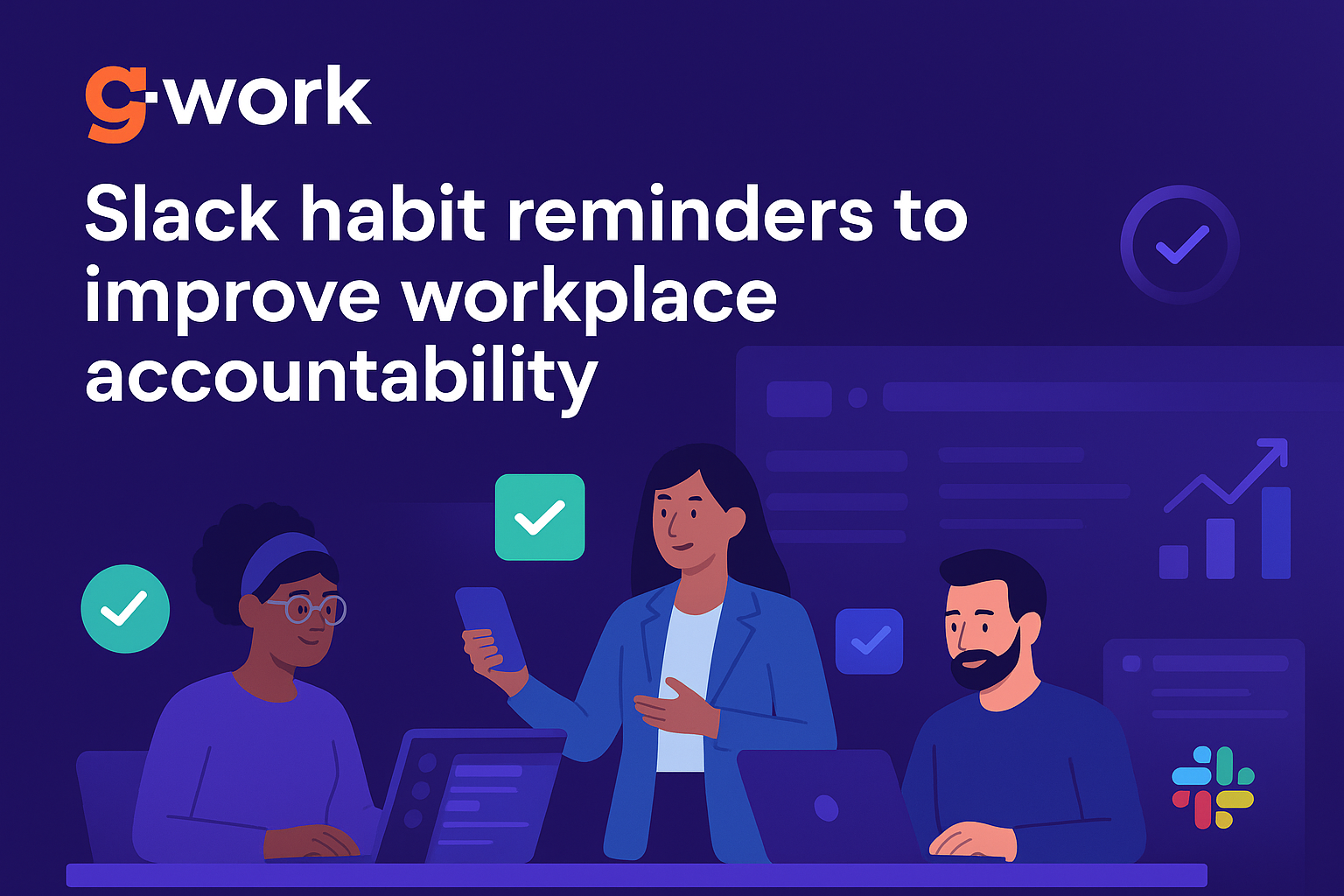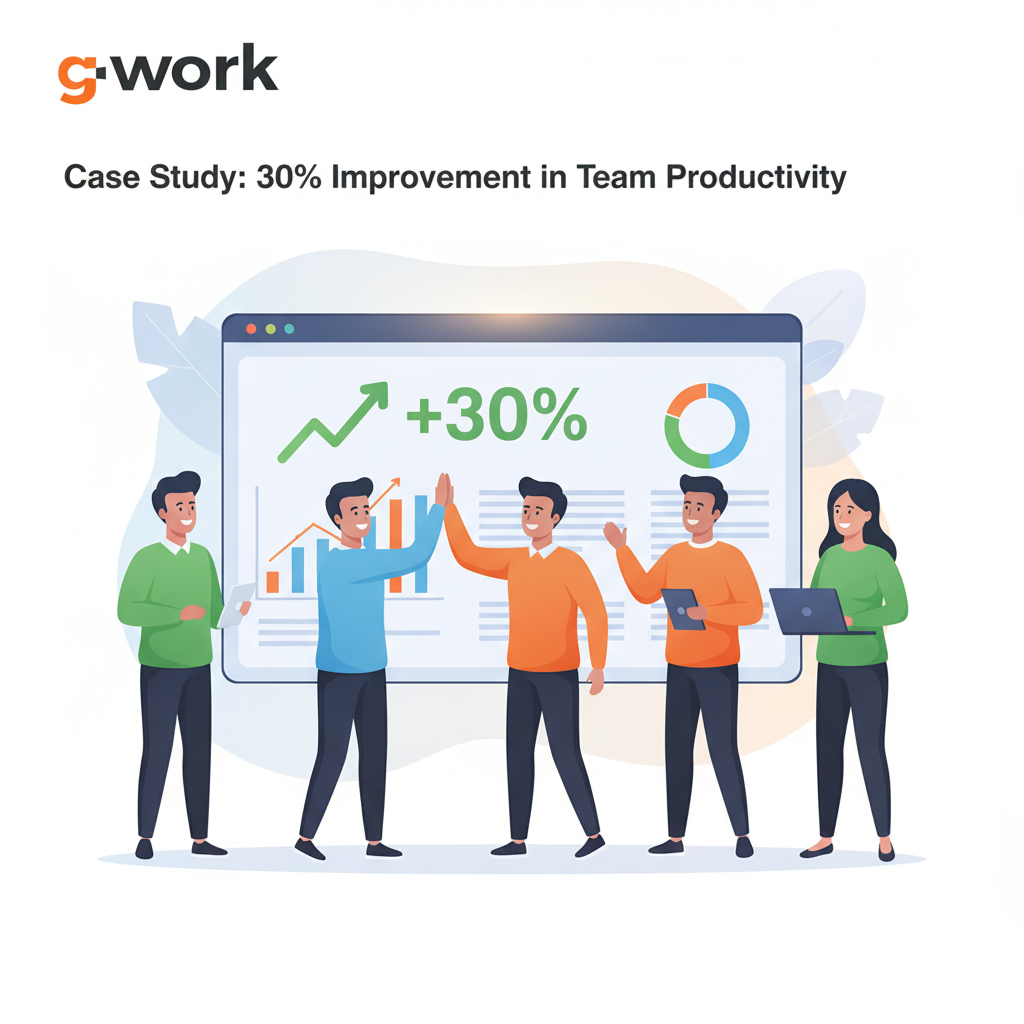Consider having a plan of your work day as opposed to wading into mails. It is not just a matter of efficiency but having different habits. The productivity, concentration and success in work are a product of habits, which are performed every day.
Good and efficient habits ensure that employees are more organized, relaxed as well as able to accomplish objectives. Poor habits, on the other hand, may lead to frustration, lack of productivity, and lack of opportunity.
The good news? Habits aren’t fixed. Every person can know how to develop productive habits, enhance them over time, and create routines that will help an individual and team to prosper.
The article discusses the science of habits, the step-by-step process of developing better habits, real-life examples, and how GWork can help employees to create a lasting change.
The Power of Productive Habits
What Are Habits?
Habits are actions that we do repeatedly and we may do this unconsciously. They lower the cognitive burden, and we get a chance to concentrate on more complicated decisions. As an example, washing your teeth or getting a morning coffee is routine.
At the workplace, habits dictate our daily routine in terms of how we begin the day, how we react to things and how we manage them. The first thing towards developing more productive work habits is to identify these patterns.
Why Productive Habits Matter
In the workplace, good habits form the foundation of workplace productivity. Workers that schedule their day, set priorities and look back on their way are likely to perform better than those who make decisions on the spur of the moment.
For example:
- Everyday strategy: Writing out the three highest priorities will decrease decision fatigue.
- Concentrated working time: Time-blocking helps in getting things done in an efficient manner.
- Taking short breaks: Keep energy up all day long and avoid burnout.
These behaviors add up in the long-run to tangible outcomes of increased productivity, team building, and less stress.
The Cost of Poor Habits
The bad habits slowly suck time and energy. Research indicates that employees dedicate more than 20 percent of their working time to unproductive distractions, such as checking email messages or between tasks. As well as decreasing individual output, these behaviors impact on group output and morale.
The Psychology of Habit Formation
The Habit Loop
The process of forming of habits takes place in a very simple loop:
- Cue: The trigger for the habit.
- Routine: The action taken.
- Reward: The benefit that reinforces the habit.
Example:
- Cue: Pings on slack notification.
- Routine: You check the message immediately.
- Reward: Being updated and informed.
This loop is critical to learning how to build good habits and getting rid of bad ones.
Why Micro Habits Are Effective
It is impossible to attempt to restructure your whole workflow simultaneously. Rather, micro habits are small steps that are easy to manage. Examples include:
- One important thing to write each morning.
- Spending 2 minutes of rest each hour.
- Taking 5 minutes to look through work accomplished at the end of the day.
These micro habits are simpler to practice and eventually result in massive changes in productivity.
Systems vs. Willpower
Motivation or will power alone usually does not work particularly on stressful days. Habits are regularly observed through systems, reminders and accountability tools. To illustrate, a mere checklist or app reminder can help avoid falling into previous ways.
Identifying Areas for Improvement
Step 1: Audit Your Current Habits
It is important to identify your behavior before you develop new habits. Follow a week of a usual working day. Ask questions like:
- What tasks do I start with?
- How often do I get distracted?
- Which habits help or hinder my performance?
Keeping a “habit diary” gives clarity on where change is needed.
Step 2: Spot Productivity Killers
Common unproductive habits include:
- Checking emails every few minutes.
- Saying “yes” to every request without considering priorities.
- Multitasking and constantly switching between tasks.
Identifying these habits allows you to focus on the behaviors that truly matter.
Step 3: Prioritize Habits That Make the Biggest Impact
Rather than transforming everything all at once, select one or two high impact habits to start enhancing them first. For example:
- Exchange multitasking with periods of concentration.
- Change informal meetings to scheduled schedules.
- Start daily priority lists.
The fewer habits you concentrate on the more chance you have of succeeding and not being overwhelmed.
Examples and Insights to Begin
Even before formal planning, small observations can help. Consider:
- Employees who start the day by listing 3 key priorities report higher focus.
- Teams that adopt structured meeting agendas reduce meeting times by 20–30%.
- Individuals who schedule short breaks avoid burnout and maintain energy throughout the day.
These insights highlight that how to build productive habits isn’t about working harder—it’s about working smarter and more consistently.
How to Build Productive Habits Step by Step
It is not possible to develop good habits out of nowhere. It needs a well-thought-out strategy, hard work, and small but practical steps. Here’s a detailed guide on how to build productive habits at work.
1. Start Small
Large objectives can be very daunting and result in procrastination. Rather than working on making yourself more productive during the night, start with micro habits– small activities that are not difficult to achieve.Examples include:
- Spend 5 minutes planning your day.
- Review one report at a time instead of multitasking.
- Take a short pause before starting a complex task to focus.
The trick is to fall into it so easily that it comes almost naturally. Small wins build momentum and reinforce consistency.
2. Stack Habits on Existing Routines
Habit stacking is an effective technique to create new habits. Connect a new habit to a habit that you have already established. For instance:
- Check the top three things after getting your morning coffee.
- Check your calendar, and send any urgent emails.
- Once a meeting is over, compose a short recap of what is to be done.
New practices are adopted more frequently and with uniformity because by combining new habits with old ones, your brain considers them to be a part of a workflow.
3. Use Triggers and Reminders
It is possible to stick to focus with the help of visual cues and digital reminders. Examples include:
- Sticky notes with key tasks on your desk.
- Calendar alerts for task start times.
- Mobile app notifications for micro goals.
Reminders put your brain on high alert and remind you that you are supposed to perform a particular action, reinforcing the cue → routine → reward.
4. Track Progress and Celebrate Wins
Tracking is essential. When you see tangible progress, your brain rewards you with a sense of accomplishment. You can:
- Maintain a habit checklist.
- Use apps or spreadsheets to log daily achievements.
- Celebrate small victories, like completing all tasks in your priority list.
These positive reinforcements make it more likely you’ll maintain the habit long-term.
5. Build Accountability
Disclosing your goals to some colleague, mentor, or manager stands greater chances of you adhering to a habit. The accountability systems may involve:
- Weekly check-ins with a peer.
- Team dashboards to show habit progress.
- Public commitment to a small change.
Your efforts are noticed by others and your drive becomes greater and your habits become more active.
6. Reinforce Habits with Rewards
Incentives make habits into an integral part of a positive reward. For example:
- Completing a time-blocked session allows a 5-minute walk.
- Finishing priority tasks early leads to early wrap-ups or small treats.
- Recognition from peers for maintaining productive routines.
These incentives, even small ones, make habits feel rewarding and worth repeating.
Overcoming Common Challenges
In spite of having a good plan, challenges occur. Learning about the pitfalls and the ways out of them is a guarantee of habit-building success.
1. When Motivation Fades
Motivation is not constant, it varies depending on mood, stress and work load. The answer: be dependant on systems rather than willpower. Checklists or reminders and GWork nudges are a few of the tools that keep the habit going despite the level of motivation.
2. Distractions and Interruptions
The contemporary working environment is rife with distractions–emails, notifications, chat messages. Combat this by:
- Time-blocking focused sessions (60–90 minutes).
- Silencing non-critical notifications.
- Creating a “do not disturb” signal for colleagues during focus time.
3. Falling Back into Old Habits
Relapse is normal. Rather than getting discouraged, begin again. Not showing up even one day is not a failure, it is an opportunity to start again in a better way.
4. Workload Overwhelm
Habits may appear to be impossible due to large workloads. Split the large tasks into small goals, set a priority on what affects the most, and monitor the improvements. Small steps will help with the momentum and help ease the stress over time.
How GWork Helps Build Better Productive Habits
What Is GWork?
GWork is an artificial intelligence-based tool which changes the behavior of employees in the workplace by helping them improve their habits. It is a combination of behavior science, AI, and practical tracking that is used to enhance productivity of individuals and teams.
Key Features That Promote Habits
- Customized Nudges – Reminders at the right time assist employees to stick to routines and keep new habits.
- Micro-Goal Tracking – Employees have mini goals and congratulate on accomplishment.
- Behavioral Insights – Managers are provided with information about the effect of employee habits on productivity in the workplace.
- Collaborative Features – Teams can share objective and motivate each other to make habit improvement together.
Practical Example: Improving Focus
One of the software teams was dealing with a lot of interruptions hence deadlines were missed. Using GWork:
- Members received nudges to start focus sessions.
- Daily micro-goals were tracked.
- Short feedback loops highlighted progress and achievements.
Within weeks, productive work habits became the norm. Focused work sessions increased efficiency, and project delivery improved.
Practical Example: Structured Meeting Habits
Inefficient meetings are another problem of teams. With GWork:
- Meetings were timed automatically.
- Key action items were recorded in the platform.
- Employees received reminders to review and follow up.
Result: shorter, more productive meetings, improved accountability, and consistent habit adoption.
[Try GWork for 360 Feedback → Get Your Free Habit Blueprint]
Practical Examples of Productive Work Habits
Here’s a list of practical habits you can adopt immediately to improve workplace productivity:
- Daily Prioritization – Write top three tasks each morning.
- Time-Blocking – Dedicate uninterrupted periods for focused work.
- End-of-Day Review – Reflect on accomplishments and plan the next day.
- Email Management – Check emails at designated times, not constantly.
- Short Breaks – Recharge every hour to maintain energy and focus.
- Meeting Discipline – Start and end on time, with clear agendas.
- Organized Workspace – Keep your desk tidy to reduce distractions.
- Feedback Routine – Ask for quick feedback at the end of projects to improve faster.
- Learning Habit – Dedicate time weekly for skill-building.
- Collaboration Ritual – Check in with teammates at consistent intervals for alignment.
Each habit may seem small alone, but together they create a high-performance, productive work culture.
Measuring and Adapting Your Habits
Habits are not only formed, it is also important to measure progress and adjust them as you go.
Track Your Progress
Monitoring helps to make sure your work has a payback. Ways to track habits include:
- Digital tools and apps: Use platforms like GWork to log daily actions and track streaks.
- Spreadsheets or journals: A simple checklist helps visualize consistency.
- Self-reflection: End-of-day or weekly reflections highlight what’s working and what isn’t.
Tracking helps you to develop awareness and motivation to keep on improving.
Analyze Results
Ask yourself:
- Are these habits increasing my workplace productivity?
- Am I completing tasks more efficiently?
- Do these habits reduce stress and improve focus?
Otherwise, modify the practice or strategy. Observe, when time-blocking is not working with 60-minute blocks, use 45-minute blocks instead.
Adapt When Needed
Habits develop as you change your role and responsibility. A manager can be more concerned with delegation and communication, whereas a team member is more concerned with completing tasks and learning new things. Whenever there is flexibility, then the habits will be relevant and effective.
Continuous Improvement
Habits are acquired gradually. Reviews once a week or once a month assist you to minimize your micro habits and incorporate more sophisticated behaviors with time. The culture of perpetual improvement and long-term productivity is created through this practice.
Real-Life Case Studies
Case Study 1: Individual Productivity
Ravi is a marketing expert who had a problem of interruptions in emails and switching of tasks frequently. He used a micro habit system:
- Checking emails only three times a day.
- Writing top three priorities each morning.
- Taking 5-minute breaks every hour.
Ravi also improved his output by 40 percent with constant practice and claimed to experience less stress. His micro habits turned into a habit, which shows that small changes produce a great outcome.
Case Study 2: Team Collaboration
Inefficient meetings and accountability delay a software development team in delivering their project. Using GWork, they:
- Received reminders to start and end meetings on time.
- Tracked action items after every meeting.
- Used micro-goals to manage tasks.
In two months, the timelines were always achieved, the time spent in meetings became shorter and more efficient, and the team turned to improved work practices as a matter of standard practice.
Case Study 3: Cross-Functional Teams
A multi-national organization observed irregular individual team performance. They also came up with habit-building workshops that were structured and encouraged the use of GWork to track daily habits. Employees said their attention was more focused, they were able to complete more tasks, and collaborated more, which demonstrated that tools and organized habit formation lead to quantifiable workplace productivity.
Advanced Tips for Sustainable Productivity
Once foundational habits are established, consider advanced strategies to maintain long-term success:
1. Layer Habits
Combine multiple micro habits into a workflow. Example:
- Morning coffee → Review top 3 tasks → Quick email check → Start focus session.
This approach ensures efficiency and reduces decision fatigue.
2. Automate Routine Tasks
Automation reduces cognitive load. Examples include:
- Email filters and scheduling.
- Auto-generated reports.
- Task reminders through tools like GWork.
Automation supports productive work habits by letting employees focus on high-value tasks.
3. Focus on Keystone Habits
Some habits have a bigger impact than others. Keystone habits create a ripple effect. Examples include:
- Daily prioritization → Better focus → Timely task completion → Reduced stress.
- End-of-day reflection → Improved planning → Efficient next day → Consistent output.
Identifying and maintaining keystone habits amplifies productivity faster than random habit changes.
4. Integrate Feedback Loops
Regular feedback enhances habit effectiveness:
- Self-assess daily or weekly progress.
- Seek peer or manager feedback on performance.
- Adjust micro habits based on insights.
5. Celebrate Milestones
Recognize long-term consistency, not just short-term wins. Celebrations—like team shoutouts, small rewards, or personal reflection—reinforce habits and keep motivation high.
How GWork Strengthens Long-Term Habit Success
Continuous Support
GWork is not only about the initiation of habits, but sustaining them over time, months and years. Its Artificial Intelligence system offers:
- Persistent nudges for consistency.
- Progress tracking for both individuals and teams.
- Data-driven insights to identify habit gaps.
Collaborative Growth
Social reinforcement is enjoyed by teams using GWork. Common purpose, streak of habits and combined micro-goals build the environment in which employees get better when they are together.
Customizable Features
GWork enables the employees to customize reminders, micro-goals, and habit trackers to their workflow. Personalization can be adopted more and the habits are realistic and usable.
Summary of Key Productive Work Habits
Here’s a concise list of core habits that drive workplace productivity:
- Daily priority setting.
- Time-blocked focused work.
- Short, regular breaks.
- End-of-day review.
- Organized workspace.
- Structured and efficient meetings.
- Feedback and reflection routines.
- Learning and skill-building sessions.
- Collaboration check-ins.
- Automation of repetitive tasks.
Adopting even a few of these consistently will lead to noticeable improvements in efficiency, focus, and job satisfaction.
Conclusion: Start Building Productive Habits Today
And developing better productive habits must be a process, not a project. Begin with micro habits, monitor, and change tactics when necessary. Minor, regular adjustments result in a major long-term improvements in individual and team productivity.
Habit-building can be more convenient and sustainable with such tools as GWork. Nudges and micro-goal tracking combined with collaboration enable GWork to ensure that habits are maintained, reinforced, and tested, and the employees perform to their best.
The point is, the larger the task, the smaller the steps, and the use of support systems. Today, start with the choice of one micro habit to adopt. With time, you will understand how a little can help you change your work day, your team and your career.
Book a Demo or Get Your Free Habit Blueprint with GWork today.
FAQs
1. What do productive habits in the workplace entail?
Good habits are those that are maintained and which enhance productivity, concentration and performance. Some examples are daily prioritization, time-blocked work and end of day reviews.
2. What am I doing to create productive workplace routines?
Begin small using micro habits, add them to pre-established routines, monitor progress, and be consistent with rewards. Get reminders and insights using tools such as GWork.
3. What are some good work habits?
Good habits are about making the most out of your tasks, resting, having an organized workspace, having effective meetings and trying to get feedback regularly.
4. What is the value of having habits in the workplace?
Habits minimize decision fatigue, conserve time, and bring about consistency. Good employee habits bring about efficiency, concentration, and team output.
5. So, what is GWork so useful in developing productive habits?
GWork is an AI-based tool that offers nudges, micro-goal tracking, behavioral insights, and collaborative features to allow employees and teams to embrace and sustain productive behaviors at work.
6. What is the time frame of developing an efficient habit?
The average time that it takes to develop a new habit is 21-66 days. Small consistent actions and consistency enhance success.
7. What are micro habits and how, why, are they effective?
Micro habits are small steps or things that are easy to practice but they will cause significant behavioral change. They also minimize resistance and facilitate adoption of a habit.










